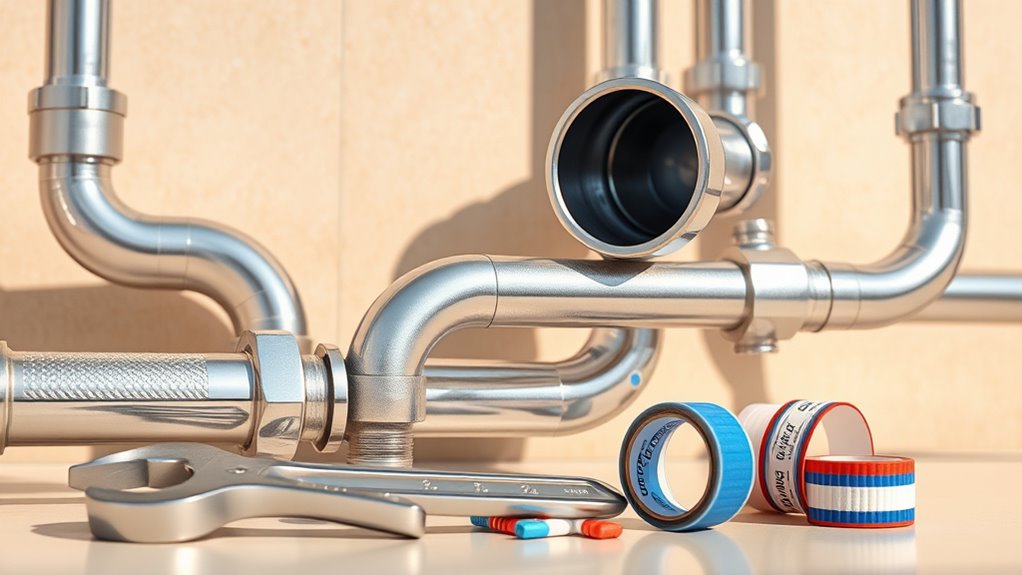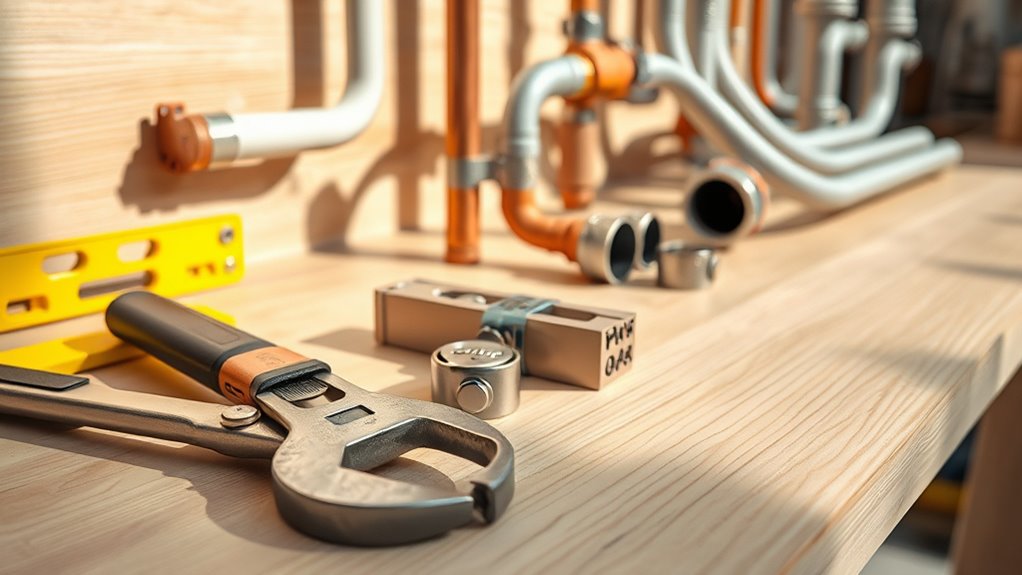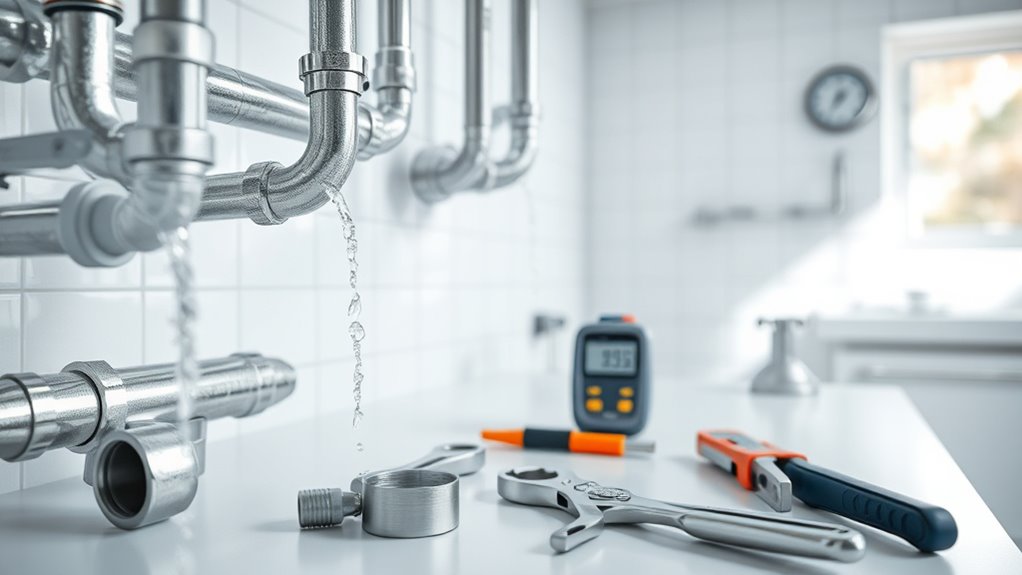Vibrating water pipes can be a nuisance in your home, often due to high water pressure, loose fittings, or water hammer. To fix this issue, start by checking for loose pipes and securing them with adjustable pipe straps. If high water pressure is the culprit, consider installing a pressure-reducing valve. Additionally, adding water hammer arrestors can help reduce vibrations. If these DIY solutions do not resolve the problem, it may be time to consult a plumber for further assistance. For ongoing prevention and a quieter plumbing system, regular maintenance is key.
Understanding the Basics of Water Pipe Vibrations

Water pipe vibrations can lead to annoying rattling or banging noises in your home. If you’re experiencing these disturbances, it’s important to understand their causes so you can find effective solutions.
Common reasons for water pipe vibrations include:
- Water Pressure Fluctuations: Sudden changes in water pressure can create noise.
- Pipe Expansion and Contraction: Temperature changes can cause pipes to expand or contract, resulting in movement and sound.
- Installation Issues: Improperly secured pipes can vibrate against walls or other structures.
- Plumbing Layout: The proximity of pipes to walls and other surfaces can amplify noise.
To address these vibrations, consider checking your water pressure, securing loose pipes, or consulting a plumber for installation adjustments.
Common Causes of Vibrating Water Pipes
If you’re experiencing vibrating water pipes, it’s important to understand the common causes and how to address them. Here’s a quick guide to help you identify and solve the issue effectively:
| Cause | Solution |
|---|---|
| High Water Pressure | Install a pressure regulator to manage pressure levels. |
| Loose Pipes | Secure or rehang pipes to prevent movement against structures. |
| Air Trapped in Pipes | Bleed the system to release trapped air. |
| Faulty Valves | Replace or repair malfunctioning valves. |
| Pipe Material | Consider upgrading to materials that dampen vibrations. |
Water Hammer: What It Is and How It Happens
Water hammer is a loud banging noise in pipes caused by a sudden change in water flow, typically when a valve closes quickly.
This phenomenon can create shockwaves that may damage your plumbing system.
To prevent water hammer, consider installing water hammer arrestors, ensuring pipes are properly secured, or gradually closing valves.
Understanding and addressing water hammer is crucial for maintaining a healthy plumbing system.
Definition of Water Hammer
Water hammer is a plumbing issue characterized by loud banging or vibrating noises when water flow suddenly stops, usually due to a valve closing.
This occurs because the inertia of the moving water creates a shock wave that travels through the pipes, resulting in high-pressure surges.
Commonly affecting faucets, toilets, and washing machines, water hammer can lead to damage over time.
If you notice this phenomenon, it’s crucial to address it promptly, as it may indicate underlying plumbing issues that need repair to prevent further complications.
Causes of Water Hammer
Water hammer is a common plumbing issue characterized by loud banging noises in the pipes. It typically occurs when there is a sudden change in water flow, often due to the abrupt closing of a valve or faucet. This sudden stop creates a shock wave that travels through the pipes.
Several factors can contribute to water hammer:
- Inadequate Pipe Support: If pipes are not properly secured, they can move and vibrate, exacerbating the noise.
- Waterlogged Air Chambers: Air chambers are designed to absorb shock, but they can become filled with water over time, losing their effectiveness.
- High Water Pressure: Excessively high water pressure can intensify the effects of water hammer.
To resolve water hammer, it’s essential to identify and address these underlying causes, ensuring a quieter and more efficient plumbing system.
Effects on Plumbing System
Water hammer can severely impact your plumbing system. It occurs when a sudden change in water flow generates shockwaves, leading to several potential problems:
- Pipe Damage: Frequent pressure surges can result in cracks or burst pipes, necessitating expensive repairs.
- Loose Fixtures: The force from water hammer can loosen connections, causing faucets and showerheads to wobble or detach.
- Increased Wear: Valves and fittings may deteriorate more quickly due to the constant stress from shockwaves.
- Noise Pollution: The loud banging noise associated with water hammer can disrupt your home environment.
To protect your plumbing system, address water hammer issues as soon as they arise.
Air Chambers: Their Role in Preventing Vibrations
Air chambers are essential devices for homeowners looking to reduce vibrations in their water pipes. Installed near fixtures, they act as a cushion for fluctuations in water pressure.
When you turn off a faucet, air chambers absorb the shock, minimizing excessive vibrations and noise, and protecting your plumbing system from potential damage.
However, air chambers can become waterlogged over time, which reduces their effectiveness. To ensure they work properly, periodic maintenance is necessary, which may include draining and refilling them to restore their air cushion.
Keeping air chambers in good condition leads to a quieter and more stable plumbing system.
Loose Pipes: Identifying and Fixing the Issue
Loose pipes can cause annoying water vibrations, so it’s important to identify them quickly.
Look for signs like rattling noises or shifting pipes, which often indicate loose connections.
To secure these loose pipes, use the right tools and techniques to restore stability and prevent further issues.
Addressing this problem promptly will enhance your plumbing system’s performance and reduce noise.
Signs of Loose Pipes
How can homeowners identify loose pipes before they cause major problems? Recognizing the signs early can save you from expensive repairs and water damage.
Keep an eye out for these key indicators:
- Vibrating Sounds: If you hear rattling or banging noises when water flows, it could indicate loose pipes.
- Visible Movement: Notice if pipes are shifting or swaying during use, especially at joints.
- Unusual Water Pressure: Inconsistent water pressure or flow can suggest instability in the pipes.
- Water Leakage: Look for damp spots or pooling water around pipes, which may indicate loose connections.
Securing Loose Connections
How to Fix Loose Connections in Plumbing
Loose connections in plumbing can lead to serious issues like vibrations and leaks. Here’s how to identify and secure them effectively.
Identifying Loose Connections
Check for movement or noise in visible pipes when water flows. Common areas to inspect include:
| Connection Type | Common Causes |
|---|---|
| PVC Joints | Age or improper installation |
| Metal Pipes | Corrosion or rust |
| Flexible Hoses | Wear and tear |
Securing Loose Connections
Once you find loose connections, take action to secure them:
- Tighten Clamps: Ensure all clamps are snug to hold pipes in place.
- Use Pipe Straps: These can help anchor pipes securely to walls or ceilings.
- Add Insulation: This can stabilize pipes and reduce vibrations.
Regular inspections will help catch loose connections early, preventing more significant plumbing problems.
Tools for Pipe Fixing
To effectively fix loose water pipes, having the right tools is crucial.
Here are four essential tools every homeowner should have:
- Pipe Wrench: Perfect for securely gripping and turning pipes.
- Adjustable Wrench: Useful for adjusting various sizes of nuts and bolts.
- Pipe Insulation: Reduces vibrations and noise while maintaining temperature.
- Screwdriver Set: Essential for tightening screws on pipe fittings and brackets.
Equipping yourself with these tools will enable you to confidently address loose pipe issues, ensuring a more stable plumbing system and preventing future problems.
High Water Pressure: Causes and Solutions
High water pressure can cause issues like vibrating pipes, disrupting the peace in your home.
It often occurs when municipal water supply settings exceed 60 psi or due to problems within your plumbing, such as incorrectly sized pipes or a faulty pressure regulator.
To tackle this, start by measuring your water pressure with a pressure gauge. If it’s too high, consider installing a pressure-reducing valve.
Regular maintenance of plumbing fixtures is also essential to prevent pressure-related problems.
Pipe Material and Its Impact on Vibrations
When selecting plumbing materials, it’s crucial to understand how pipe material affects vibrations and noise levels.
Here’s a quick overview of common pipe materials and their impact on vibrations:
- Copper: Rigid and transmits vibrations easily, often resulting in noticeable noise.
- PVC: Lightweight and less dense, it dampens vibrations for quieter operation.
- Steel: While robust, it effectively transmits vibrations and can increase noise levels.
- PEX: Flexible and resilient, it absorbs vibrations well, minimizing sound from flowing water.
Choosing the right material can significantly enhance the comfort of your plumbing system.
Faulty Valves: Recognizing the Signs
If you’re experiencing issues with your water flow, faulty valves could be the cause.
Here are key signs to watch for:
- Water Pressure Changes: If you notice fluctuations in water pressure, it may indicate a malfunctioning valve.
- Unusual Noises: Sounds like banging or hissing might signal air or water hammer related to valve issues.
- Leaks: Check for leaks around the valve area, as this can point to a significant problem.
- Erratic Water Flow: If the water flow is inconsistent or stops entirely, it likely indicates a valve malfunction.
Identifying these signs early can help you address potential repairs or replacements, safeguarding your plumbing system.
Sediment Buildup: How It Affects Your Pipes
Sediment buildup in water pipes can significantly affect water flow and pressure due to mineral deposits and debris from aging infrastructure.
To prevent reduced water pressure and potential damage, it’s crucial to perform regular maintenance and take preventative measures.
Addressing sediment buildup promptly can help ensure your plumbing system remains efficient and functional.
Causes of Sediment Buildup
If you’re experiencing sediment buildup in your plumbing, it’s essential to understand the common causes to effectively address the issue.
Here are the main factors contributing to sediment accumulation:
- Hard Water: High levels of minerals like calcium and magnesium can lead to mineral deposits in your pipes.
- Corrosion: Aging pipes may corrode, causing rust and debris to enter your plumbing system.
- Poor Filtration: Ineffective filtration systems can allow sediment and particles to flow through your water supply.
- Stagnant Water: Water that remains still for long periods encourages sediment to settle, particularly in low-flow areas.
Impact on Water Flow
Sediment accumulation in plumbing systems can significantly disrupt water flow.
Over time, minerals, rust, and debris can settle in pipes, narrowing the passage for water. This results in reduced water pressure, leading to inconsistent flow from faucets and showerheads.
Homeowners might experience uneven water distribution, where some areas receive less water than others. In severe cases, blockages can occur, requiring costly repairs.
To maintain optimal water flow and prevent long-term plumbing issues, it’s crucial to address sediment buildup promptly.
Prevention and Maintenance Tips
To prevent sediment buildup in your plumbing system, follow these essential maintenance tips:
- Flush Your Water Heater: Every six months, flush your water heater to eliminate sediment and maintain efficiency.
- Install Sediment Filters: Add filters to your incoming water lines to trap impurities before they enter your plumbing.
- Schedule Annual Inspections: Have a professional inspect your plumbing yearly to catch potential sediment issues early.
- Consider Water Softeners: If you live in a hard water area, a water softener can reduce mineral deposits in your pipes.
Implementing these strategies will help maintain your plumbing and improve water quality.
Temperature Changes and Their Effects
Temperature fluctuations can cause vibrating water pipes in your plumbing system. When water heats up, it expands, increasing pressure in the pipes.
Conversely, as water cools, it contracts, altering the pressure dynamics. These changes can lead to water hammer, which causes pipes to vibrate or clank when water flow stops suddenly.
Poorly secured pipes can worsen this issue by allowing movement and noise. To address vibrations, focus on proper insulation and pipe support to stabilize your plumbing system.
DIY Solutions for Water Hammer
DIY Solutions for Water Hammer
If you’re dealing with water hammer in your home, here are some effective DIY solutions to reduce noise and vibrations:
- Install Water Hammer Arrestors: These devices absorb shocks from water flow, preventing hammering sounds.
- Secure Loose Pipes: Use pipe clamps or brackets to stabilize any pipes that may be moving excessively during water flow.
- Adjust Water Pressure: Use a gauge to check your home’s water pressure; if it exceeds 60 PSI, consider reducing it.
- Drain the Plumbing System: Turn off the main water supply, drain the pipes, and then refill them to eliminate trapped air pockets that contribute to water hammer.
Reinforcing Loose Pipes: Step-by-Step Guide

To reinforce loose pipes and prevent vibrations in your plumbing system, follow these simple steps:
- Identify Loose Connections: Check for any areas where pipes may be loose or not properly secured.
- Install Pipe Supports: Add supports to stabilize the pipes and prevent movement.
- Secure with Straps: Use straps to firmly hold the pipes in place, minimizing the risk of future vibrations.
These steps will help ensure your plumbing system operates smoothly and quietly.
Identify Loose Connections
If you’re dealing with vibrating water pipes, loose connections are often the culprit.
Here’s how to quickly identify and fix them:
- Inspect Visible Pipes: Check for any pipes that shake or move when water is flowing.
- Check Fittings and Joints: Ensure all fittings and joints are tightly secured.
- Listen for Noises: Be alert for unusual sounds while using water, as they may indicate loose connections.
- Feel for Vibration: Run your hand along the pipes to feel for any vibrations.
Use Pipe Supports
To effectively stabilize vibrating water pipes, using pipe supports is essential. Here’s how to do it:
- Identify Unsupported Sections: Locate areas where the pipes lack adequate support.
- Select Appropriate Supports: Choose pipe supports like brackets or clamps that fit the diameter and material of your pipes.
- Prepare the Area: Ensure the installation area is clean and dry.
- Install Regularly: Attach pipe supports every four to six feet, fastening them securely to both the pipe and structural framework.
- Check for Vibration: After installation, assess for any remaining vibrations and adjust the supports if needed.
Secure With Straps
How to Secure Loose Pipes with Straps
If you’re dealing with loose pipes that cause vibrations and noise, securing them with straps is a simple and effective solution. Follow these steps to stabilize your plumbing:
- Identify Loose Sections: Look for pipes that lack proper support.
- Choose Appropriate Straps: Use heavy-duty, adjustable pipe straps that match the diameter of your pipes.
- Position Straps: Wrap the straps around the pipes and secure them to the wall or beam, ensuring a firm fit without over-tightening.
- Check Stability: After securing, gently shake the pipes to ensure they are stable and vibrations are minimized.
Adjusting Water Pressure: A Simple Fix
Adjusting water pressure can effectively stop vibrating water pipes in your home. If your pipes are noisy, it may be due to high water pressure.
To check your water pressure, use a pressure gauge connected to an outdoor spigot or a washing machine connection; the ideal range is 40 to 60 psi. If your pressure is too high, locate the pressure-reducing valve near the water meter and adjust it downwards.
This will not only reduce vibrations but also protect your plumbing fixtures and appliances from damage. Regularly monitor your water pressure to ensure it stays within the recommended range for optimal performance.
When to Seek Professional Help

When to Seek Professional Help for Vibrating Pipes
High water pressure can cause vibrating pipes, but certain signs indicate you may need professional assistance.
Look for these warning signs:
- Persistent Vibrations: If your pipes continue to vibrate after you’ve adjusted the water pressure.
- Strange Noises: Banging or clanging sounds often point to underlying issues.
- Leaks: Any visible leaks or water stains could mean damage in your plumbing system.
- Decreased Water Flow: A drop in water pressure may signal blockages or complications.
Addressing these signs quickly helps prevent further damage and ensures your plumbing works effectively.
Preventive Measures to Avoid Future Vibrations
To prevent vibrations in your water pipes, follow these essential steps:
- Regular Monitoring: Inspect your plumbing system for wear, damage, and secure connections.
- Install Water Hammer Arrestors: These devices absorb shocks from sudden water flow changes, minimizing vibrations.
- Adjust Water Pressure: Ensure your water pressure is within the recommended range to avoid excessive vibrations.
- Flush the Water Heater: Regularly flushing helps maintain optimal flow and reduces noise.
- Clean Aerators: Keeping aerators clean promotes better water flow and minimizes disturbances.
- Schedule Routine Inspections: Hire a licensed plumber to identify potential issues early on.
These measures will help maintain a quieter and more efficient plumbing system.
Conclusion
If you’re dealing with vibrating water pipes, it’s essential to understand the causes and find easy solutions to restore peace in your home. Common reasons for this issue include water hammer, loose pipes, or high water pressure.
To fix vibrating pipes, consider these DIY solutions:
- Water Hammer Arrestor: Install a water hammer arrestor to absorb the shock of water flow and prevent vibrations.
- Secure Loose Pipes: Check for loose pipes and secure them with straps or brackets to minimize movement and noise.
- Adjust Water Pressure: If high water pressure is the culprit, use a pressure regulator to lower it to a safe level.
- Drain the System: Sometimes, air trapped in the plumbing can cause vibrations. Draining the system and refilling it can resolve the issue.
By addressing these problems directly, you can restore harmony to your plumbing system and enjoy a quieter home.

I’m Allen Kim, the chief editor of plumbinginto. I am a mid level plumber and assign to an local firm over 4 years of experience. During the working period, most of my experience is related to the house plumbing. I learned about the thing, when working with most experienced people in this sector, one must be as good as the inspector or better with knowledge of the project as well as the practical aspects of plumbing industry.